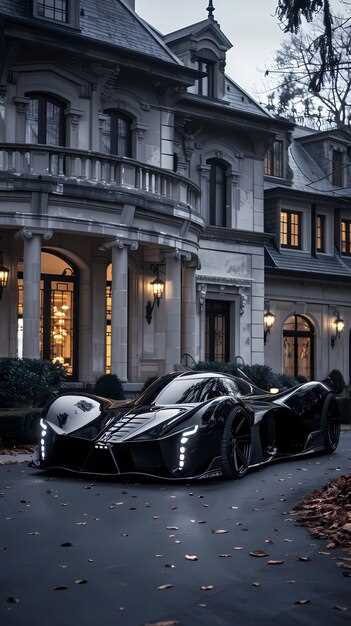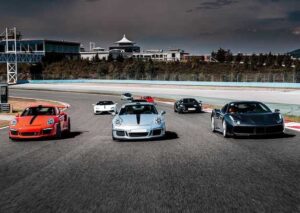If you’re seeking the pinnacle of automotive luxury and performance, turn your attention to the most expensive supercars sold at auction. These remarkable machines not only represent unparalleled engineering but also command staggering prices that leave enthusiasts in awe. The global auction scene has witnessed some jaw-dropping sales, where rare models fetched millions, showcasing both rarity and desirability.
Among these coveted vehicles, the Ferrari 250 GTO stands out, fetching an astonishing $48.4 million in a 2018 auction. This iconic model, with its racing pedigree and limited production, remains a cherished piece of automotive history. Buyers are not only investing in a car but also in a storied legacy that elevates these vehicles beyond mere transportation.
The Lamborghini Veneno is another masterpiece that exemplifies the supercar allure. Its sale price of $8.3 million underscores the demand for exclusivity and cutting-edge design in the supercar community. Such figures reflect not just the car’s specs but also the cultural significance it carries among collectors. Every sale tells a story, connecting buyers with a unique moment in automotive evolution.
As collectors pursue these legendary supercars, understanding the factors that influence auction prices becomes critical. Rarity, condition, provenance, and market trends all play significant roles in determining how much these gems are worth. Whether you’re considering a potential purchase or simply an admirer, keeping an eye on auction results can provide invaluable insights into this electrifying market.
Top 5 Most Expensive Supercars Ever Auctioned
The auction world has witnessed record-breaking sales of supercars that reflect both engineering excellence and collector’s desire. Here are the top five most expensive supercars auctioned to date.
1. 1955 Ferrari 410 Sport Spider – This legendary car fetched a staggering $22 million at a RM Sotheby’s auction in 2014. Its storied racing history, driven by legends like Juan Manuel Fangio, contributes significantly to its appeal.
2. 1937 Talbot-Lago T150-C-SS Teardrop Coupe – In 2015, this stunning Talbot-Lago sold for $13.4 million. The car’s striking Art Deco design and rarity as one of only 14 produced make it a true gem among collectors.
3. 2003 Ferrari F2003-GA F1 Racer – Driven by Michael Schumacher, this iconic Formula 1 car brought in $14.9 million at auction in 2017. Its association with incredible racing success elevates its status in the world of motorsports memorabilia.
4. 1957 Ferrari 335 Sport Scaglietti – This car achieved $12 million at a Pebble Beach auction in 2016. The combination of its sleek design and powerful engine, along with a notable racing pedigree, makes it a sought-after model.
5. 1995 McLaren F1 – The McLaren F1, known for its unique three-seat layout and exceptional speed, reached $15.6 million at an auction in 2019. Its rarity and engineering brilliance make it a highlight in supercar history.
These supercars not only represent automotive excellence but also symbolize the intersection of art and engineering in collector culture.
Factors That Increase Supercar Auction Prices
Rarity plays a pivotal role in determining auction prices. Limited production models or unique variants often attract higher bids due to their exclusivity. Collectors seek out these rare finds to enhance their portfolios and showcase unique assets.
Provenance significantly influences value. A supercar with a rich history, such as ownership by a celebrity or participation in notable racing events, can command a premium. Documenting the car’s backstory adds to its allure and desirability among buyers.
Condition remains a priority. Well-preserved cars with low mileage and original parts fetch higher prices. A comprehensive service history and professional restoration further enhance appeal, providing potential buyers with confidence in their investment.
Brand reputation matters. Established manufacturers like Ferrari, Lamborghini, and Bugatti consistently attract high bids due to strong brand loyalty and performance heritage. Limited editions or special releases from these brands typically see increased demand.
Market trends affect pricing dynamics. Economic conditions, collector interest, and emerging buyer demographics influence auction outcomes. A surge in interest for specific models can lead to skyrocketing prices at auction, driven by passionate bids fueled by current market conditions.
Timing influences sales. Holding an auction during peak seasons or notable automotive events can yield better results. Buyers are often more willing to spend during times when they feel more financially secure or motivated by the excitement surrounding a major automotive showcase.
Finally, effective marketing of the auction creates buzz. Quality presentation, including high-quality photographs and detailed descriptions, can attract more potential bidders. Engaging storytelling around the vehicle can inspire interest, driving up competition and prices during the auction.
How Rarity Affects Supercar Value at Auction
Rarity significantly boosts the auction value of supercars. Limited production runs create exclusivity, turning these cars into coveted collectibles. Brands such as Ferrari or Lamborghini often limit their models to a few dozen units, intensifying demand.
- Production Limits: Supercars produced in quantities lower than 100 units tend to fetch the highest prices. For example, a Ferrari FXX-K, created in limited numbers, has reached auction prices above $3 million.
- Heritage and Brand Exclusivity: Cars that are part of a company’s legacy, like the McLaren F1, gain additional value. With only 64 road-legal models made, these often sell for over $15 million.
- Unique Features: One-off customizations or special editions can enhance a car’s appeal. The Bugatti Chiron Super Sport 300+ sold for around $3.9 million, partly due to its unique design and engineering.
Investors focus on the history and engineering excellence behind each model. Well-documented provenance can elevate the value significantly. Auction houses often highlight a supercar’s backstory, drawing attention from collectors.
- Documented History: Cars with a rich racing or celebrity background attract higher bids.
- Condition and Authenticity: Original components, service records, or lack of scratches can dramatically impact the final sale price.
Consider models that have turned into icons. The appreciation in value for models like the Porsche 917 has proven that rarity, combined with historical significance, translates to lucrative auction returns.
In summary, rarity plays a central role in determining supercar values at auctions. Take note of production numbers, brand prestige, and unique features to make informed investment choices in this thrilling market.
Notable Auction Houses Specializing in Supercars
Bonhams stands out as a leading auction house for supercars, known for its dedicated automotive sales. Their sales often include high-profile models, and they attract collectors from around the globe. With a reputation for handling rare finds, Bonhams frequently features iconic brands like Ferrari and Lamborghini.
RM Sotheby’s has an impressive track record in supercar auctions, combining luxury with expertise. Their events spotlight rare vehicles and attract a diverse clientele. RM Sotheby’s often collaborates with manufacturers to present exclusive models during major auctions, enhancing their appeal.
Gooding & Co. is renowned for its high-energy auctions where supercars take center stage. Their team consists of automotive experts who assess and curate vehicles meticulously. This auction house has successfully driven record sales, making headlines with rare vintage and contemporary models like McLaren and Bugatti.
Christie’s, although primarily known for fine art, holds specialized automobile auctions that feature luxurious supercars. Their auctions blend the sophistication of art with the excitement of car collecting, showcasing limited-edition models that collectors cherish.
| Auction House | Specialty | Notable Sales |
|---|---|---|
| Bonhams | Dedicated automotive sales | Ferrari F1 cars |
| RM Sotheby’s | Luxury and exclusivity | Ferrari 250 GTO |
| Gooding & Co. | High-energy auctions | McLaren P1 |
| Christie’s | Fine art and automobiles | Limited-edition Bugatti |
Each of these auction houses offers a unique platform for supercar enthusiasts. Their proven expertise and selective curation create an unparalleled experience for buyers and sellers alike.
Profile of a Successful Supercar Collector
Focus on specific brands known for their value appreciation, like Ferrari and Bugatti. Research their history and significant models to build a well-informed collection. Understanding market trends helps identify which models will likely yield higher returns.
Attend auctions and car shows to network with other collectors and industry experts. Building relationships within the community opens doors to rare finds and insider knowledge about upcoming models or exclusive releases.
Invest in proper storage and maintenance of your collection. A climate-controlled environment protects the cars from deterioration, while regular servicing keeps them in excellent condition, enhancing their resale value. Document every vehicle’s history, including service records and previous ownership, to maintain provenance.
Consider uniqueness and rarity when adding to your collection. Limited editions or cars with historical significance can attract higher bids at auctions. Utilize resources like detailed market reports and auction results to stay updated on which models are gaining interest.
Finally, maintain your passion for supercars. Genuine enthusiasm attracts fellow collectors, creates a positive reputation, and can lead to opportunities not available to lesser-known individuals. Share your knowledge and experiences through online forums or local clubs to further immerse yourself in the community. This involvement will enhance both the enjoyment and potential profitability of your collection.
Future Trends in Supercar Auction Markets
Anticipate a rise in online auction platforms catering specifically to supercars. The convenience of bidding from anywhere attracts tech-savvy collectors. Platforms like Bring a Trailer have already set the stage, highlighting the impact of digital engagement in sales.
Expect increasing interest in electric supercars. Many manufacturers are shifting focus towards hybrid and electric models, drawing attention to their auction potential. Brands like Rimac and Tesla’s Roadster are already raising eyebrows, suggesting future bids will center around sustainability and high performance.
Watch for a surge in auctions featuring exclusive editions. Limited-run models will likely command higher prices as collectors vie for rare pieces. Events promoting these unique offerings will become more frequent, enhancing their desirability in auction circles.
Data analytics will play a pivotal role in understanding market trends. Bidders will utilize data to assess value fluctuations, identifying patterns in recent auctions. Auction houses may adopt these insights to showcase the most sought-after vehicles, guiding collectors as they bid.
Expect more collaborations between artists and auto manufacturers. Unique customizations and collaborations could drive up interest and pricing at auction. Imagining supercars as artwork will attract both car enthusiasts and art collectors, widening the market scope.
Geographical shifts in demand may emerge. Regions once overshadowed by traditional markets could become hotspots. Emerging economies with growing luxury sectors may show interest in high-end vehicles, further diversifying auction participants.
Finally, anticipate stricter regulations regarding classic supercars. New environmental standards may affect the value and eligibility of older models. Buyers should remain informed, as compliance with these regulations could influence future auction outcomes.







